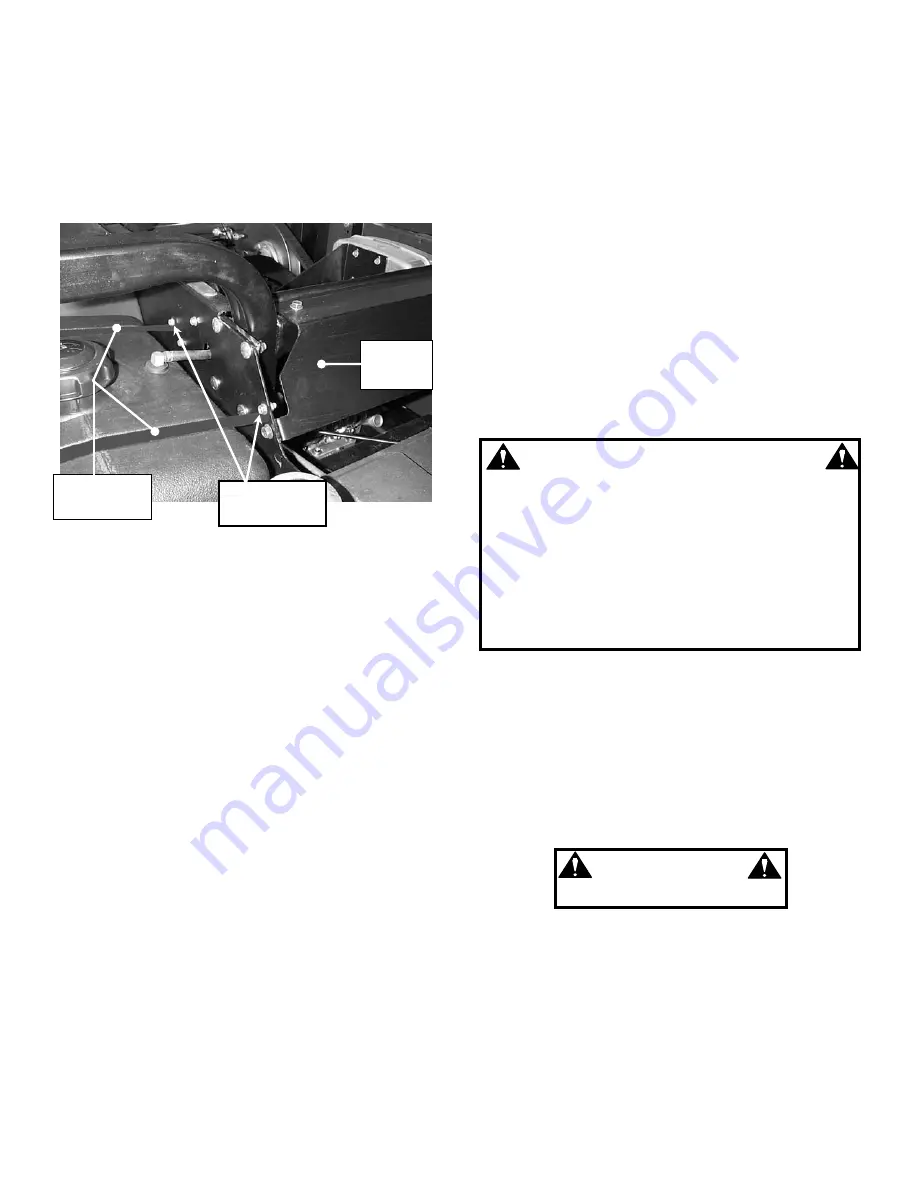
3
STEP 6
INSTALL OPERATOR PROTECTIVE
STRUCTURE (OPS)
The installation of the Operator Protective Structure
requires two people. The mounting hardware for the
OPS and seat belts must be properly torqued. Do Not
modify the OPS in any way. Install the OPS with the
“WARNING” sign on the right (passenger’s) side of the
machine.
FIGURE 1.4
1. Locate the mounting hardware – (12) 3/8-16 x 1”
round head carriage bolts and (12) 3/8-16 Nyloc
nuts. Place 6 of each in the left and right seat
support tray for easy access when attaching OPS
to frame.
2. Raise OPS to vertical position and orientate so that
the “WARNING” decal located on the side of the
OPS is on the passenger’s side of the machine.
3. Align holes in OPS with holes in frame. Get (1)
carriage bolt started on each side. NOTE: insert
bolts with head towards outside of frame as shown.
Secure with 3/8-16 Nyloc nut. Do not tighten at this
time.
4. Install remainder of the bolts and secure each with
a Nyloc nut.
5. Torque ALL OPS mounting hardware to 30-35 ft-lb.
6. Reattach fuel tank straps. Tighten hardware
securely.
7. Attach heat shield to OPS using (2) 5/16-18 self-
tapping bolts. Do Not tighten at this time.
8. Attach heat shield to left and right frame rails using
(2) 5/16-18 x 7/8” bolts and (2) 5/16-18 NyLoc nuts.
9. Tighten all heat shield hardware securely.
10. Reattach fuel tank straps. Tighten hardware
securely.
STEP 7
ENGINE OIL AND TRANSMISSION FLUID
The engine oil and transmission fluid must be checked
before operation.
1. Fill engine crankcase to proper level. Refer to
Engine Owner’s Manual for capacity and oil
specifications. Check with dipstick unthreaded.
2. Check transmission fluid level. Bring to full level as
necessary using MOBILFLUID 424 or equivalent.
Check with dipstick fully threaded.
STEP 8
ACTIVATE BATTERY
Battery is located under the operator’s seat. Remove
battery from compartment before activating or charging.
Activate and charge the battery in well ventilated area
away from sparks and flame. Do Not smoke.
1. Remove battery from the battery compartment
before charging.
2. Place battery in a well ventilated area on a level
non-concrete surface.
WARNING
The electrolyte (acid) produces a highly explosive gas.
Keep all sparks, flame and fire away from area when
charging battery or when handling electrolyte or
battery. Electrolyte (acid) is a highly corrosive liquid.
Wear eye protection. Wash affected areas immediately
after having eye or skin contact with electrolyte (acid).
Battery acid is corrosive. Rinse empty acid containers
with water and mutilate before discarding. If acid is
spilled on battery, bench, or clothing, etc., Flush with
clear water and neutralize with baking soda.
3. Remove battery cell caps. Fill cells as required with
electrolyte (purchased separately) to proper level.
Fill to 3/16” above cell plates. Filling battery with
electrolyte will bring the battery to 80% of full
charged state.
IMPORTANT: 3/16” above cell plates is the
recommended level. Never place anything in battery other
than specified electrolyte.
WARNING
DO NOT OVERFILL!
4. With cell caps removed, connect battery charger to
battery terminals; RED to positive (+) and BLACK
to negative (-) terminal.
5. Slow charge the battery at 4 to 6 amps for 2 hours
to bring the battery to full charge.
6. After charging, check level of electrolyte and add as
needed to bring level to 3/16” above cell plates.
7. Reinstall cell caps. Tighten securely to prevent
leakage.
FUEL TANK
STRAPS
REMOVE TOP
TWO BOLTS
HEAT
SHIELD
























